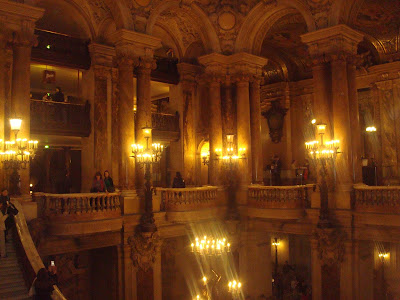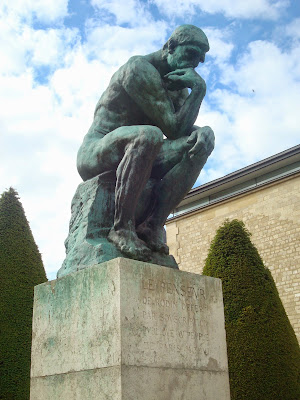Self-guided tours are available for ten euros.
But out of curiosity, I decided to check how much a performance would cost, all the while thinking that it was likely out of my price range.
When I found out that the cheapest seat with a decent view only cost twenty euros, my mind was made up. We were going to go watch a ballet at the Palais Garnier.
 So I went online, purchased tickets, and enjoyed a great ballet, end of story...
So I went online, purchased tickets, and enjoyed a great ballet, end of story...... oh, if only things were that simple.
I went online but tickets were "unavailable". Taking it to mean that the tickets have been completely sold out, it was looking like the self-guided tour for us. What I didn't know was that the tickets haven't gone on sale yet. The Paris Opera website actually has a schedule indicating when tickets would go on sale, which I didn't see. If you're interested, there is a great guide on buying tickets online here.
By the time I realized this, all the affordable tickets were long gone. The 20 euro, cat. 4 tickets are usually sold out within an hour or so.
I then signed up for the Paris Opera ticket exchange but I never seemed be to be quite fast enough. Yep, those ballet tickets were coveted items.
Some folks online had mentioned rush seats and partial view seats being available the day of the performance. After checking online and finding that partial view seats only cost 10 euros, the same as a self-guided tour, I figured I'll try my luck.
Box Office Entrance
So while my travel companions enjoyed their dinner at a restaurant near the theatre, I headed off to the box office. By the time I got there, which was about an hour before the box office opened, a line of about twenty people had already formed.
As the agent was selling me the cat. 6 tickets (everything else was sold out), she made sure to emphasize that the views were very obstructed and only one-tenth of the stage can be seen.
I bought the tickets anyways, figuring if the view was really as bad as she said, we'll just wonder around the theatre and go home early. It would be as if we did the self-guided tour.



Don't these nymph statues look like they've been imprisoned by the metal belt around their waist? Doomed to hold the lamps high for eternity. Total YA story material.
 The hard-won tickets. Note how it says "scene non visible."
The hard-won tickets. Note how it says "scene non visible."I had chosen Paquita over L'histoire de Manon because the plot of the former seemed easier to follow.
Basically, the gypsy Paquita and a noble fall in love. Bad guys try to interfere but the lovers persevere. Turns out Paquita is actually the long-lost daughter of another noble. They wed. Everyone is happy. The end.
Inside the opera house
Stunning. And not just because of the facade but the entire atmosphere. The candlelight effect completely transported you back to a period of corsets, evening gowns and tuxedos.






I don't know why there's not a better photo of the grand staircase. I think I was just completely overwhelmed by my surroundings.
 Our seats were off to the side, in one of the private boxes.
Our seats were off to the side, in one of the private boxes.Ironically, in the olden days these seats were probably more expensive than those in the stalls with the better view.
Each private box had six seats, arranged into three rows of twos. We were seated in the second and third row.
Everything was covered in red velvet, even the walls. It was luxurious but also stifling hot. How did the heavily-gowned, corseted ladies survive these 2-3 hours ordeals?
From our seats, we were able to see about 1/2-1/3 of the stage.

The famous Chagall ceiling.
The Royal Box?
Sorry about the blurriness. I wish my camera wasn't so crummy in low light conditions. The gilded details of the opera house were breathtaking.
During intermission, I had the chance to explore some more.


The bats on the ceiling of the Salon de La Lune were delightful.


Paquita (from what we could see) was brilliant. The prima ballerina was exquisite - graceful but powerful. All the ballet dancers were so light on their feet, unlike another ballet I saw elsewhere a few years back. And the synchronicity of the ballet corps was just unbelievable.
In the end, we had to stand for most of the ballet to get a better view (about 2/3 of the stage) and there were times that I desperately wished the prima ballerina didn't favour the other side of the stage so much.
Would I return? A definite yes. And I'll be prepared to get better seats next time.





































